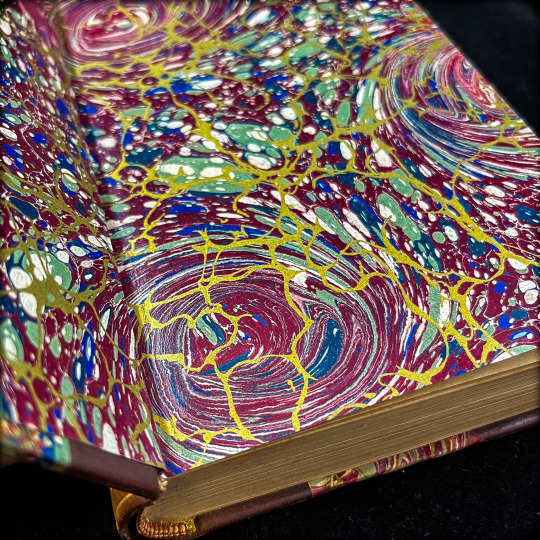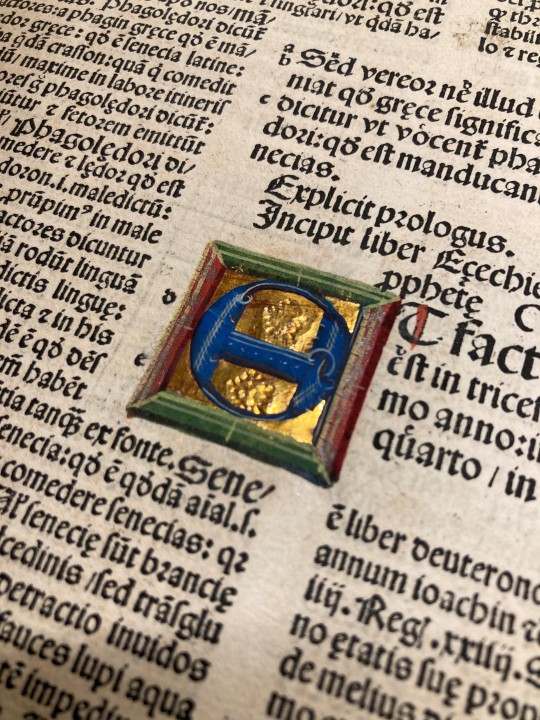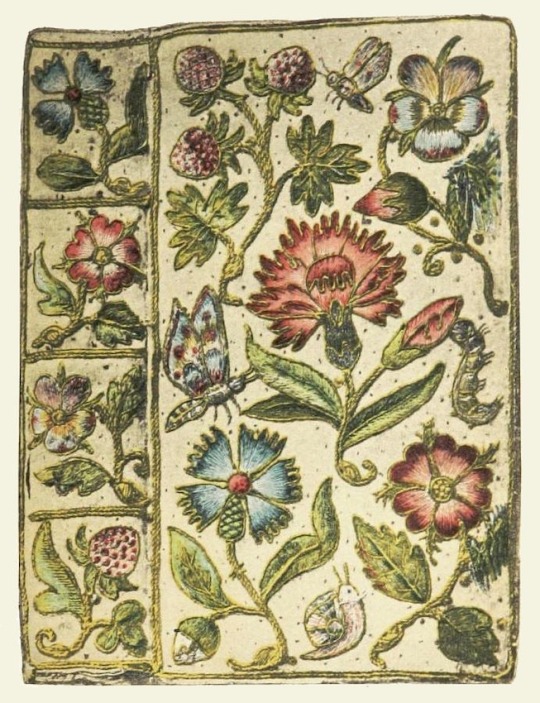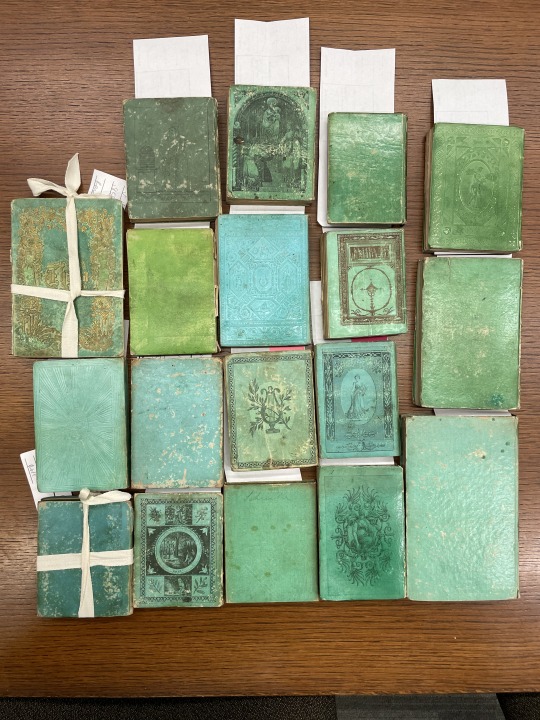#rare books
Text
A jewel box of a book ✨ This 19th century French sales sample book contains very thin metal ornaments, made of foil over card. These would have been used like fancy sequins, and adorned everything from cards to clothes! They’re sometimes called Dresdens after the town in Germany where many were made. I know I say this a lot, but this book really floored me 🤩 Part of col. 838 in the Winterthur Library 📚
10K notes
·
View notes
Text



Embroidered book covers
#beautiful books#book blog#books books books#book cover#books#rare books#embroidered#embroidery#book design#book binding
6K notes
·
View notes
Text
I'd like to introduce you to LJS 57, a compendium of Astronomical text in Hebrew, written in Spain around 1391. It's an interesting combination of astronomy and astrology, and illustrates how the division between "science" and "not science" was not nearly so clear in the past as it is today. It has some fantastic illustrations of constellations!
🔗:
#medieval#manuscript#medieval manuscript#14th century#hebrew#astronomy#astrology#stars#constellations#illustrations#illuminations#diagrams#history of science#book history#rare books
4K notes
·
View notes
Text

The periodically controversial signs which sometimes adorns the bookshop door
#old#books#old bookshop#bibliophile#old books#michael moon's bookshop#antiquarian#antique books#findingnewhomesforoldbookssince1970#rare books#Whitehaven#michaelmoonsbookshop#Moonsbookshop
4K notes
·
View notes
Text

640-year-old fly, anyone?
We're not sure how long this fly has been in this 14th-century notary's notebook, but it was a favorite among the students who spotted it in class a few weeks ago.
La Turade, Bernard de. [Notarial Registry]. 1383-1393. VAULT DC95.A2 N6 1383
#manuscript monday#medieval manuscript#bookhistory#fly#mizzou#special collections#libraries#university of missouri#rare books#history#books#things found in books
407 notes
·
View notes
Text
Drum roll please… we have a winner for the super unique copy of @neil-gaiman 🌟STARDUST🌟

623 notes
·
View notes
Text

The marbling pattern on the boards and endpapers of our late nineteenth-century multi-volume set of John Morley's English Men of Letters is marked by colorful spirals. I wonder if there's a metaphor here: enter the irresistible whirlpools of knowledge and lose yourself in all the information contained within!



Images from: Morley, John, ed. English Men of Letters. New York: Harper & Bros., ca. late nineteenth century. Catalog record: http://bit.ly/40F5jaR
2K notes
·
View notes
Text

I LOVE a well used and well annotated book! Any signs of actual, everyday usage is such a wonderful find in rare books.
This is found in our copy of Bouquet composé des plus belles fleurs chimiques (1629) by David de Planis Campy.
383 notes
·
View notes
Text


Marshmallow, Signed by Author Clare Turlay Newberry 1st Edition Vintage Children's Book in Dust Jacket. by StompingGroundsBooks
#StompingGroundsBooks#vintage book#vintage childrens book#vintage#book#books#rare books#vintage rare book#rabbit#cute#cat
303 notes
·
View notes
Text




A mixed bag of letters and animals (featuring a couple of dragons!) from a beautiful 1525 book of Canon law. Someone please make these decorated initials into Bananagrams tiles.
#riesenfeld center#umn#university of minnesota law#university of minnesota law library#rare books#umn law#special collections#archives#law#canon law#dragons#initials#bananagrams
585 notes
·
View notes
Text

Framed
We found a glittering surprise when we opened this volume from 1501/02. The book contains the Latin text of the biblical book of Ezekiel, along with commentary by the 13th century Dominican priest, Hugh of St. Cher.
The decorated letter here (the only one found in this volume) has a frame border which itself echoes the framing of the biblical text by its commentary.
Biblia latina cum postillis Hugonis de s. Charo.
[Basel : Johann Amerbach for Anton Koberger, 1498-1502]. (v.5)
275 notes
·
View notes
Text
Little Isaac Bawden was quite the calligrapher! 🖌️ This 1763 arithmetic book shows off his flourishing skills. The later 1880s Golden Gems of Penmanship, published during the calligraphy revival of the 19th century, allows us to see how Isaac learned this art! Isaac’s book has been digitized, and you can find it here 📖
(Doc. 743 at the Winterthur Library)
936 notes
·
View notes
Text

HORAE SUCCESSIVAE by Henshaw (1632)
Beautiful book cover of white satin with a floral design edged in gold cord, featured in Cyril Davenport’s English Embroidered Book-bindings (1899).
#beautiful books#book blog#books books books#book cover#books#antique books#rare books#book binding#book design#embroidered#embroidery
837 notes
·
View notes
Text
LJS 64 is a book of diagrams, many with moving parts, designed to accompany the work Theoricae novae planetarum by 15th-century Austrian Georg von Peurbach, who is considered one of the first modern astronomers. He was particularly interested in simplifying the Ptolemic system (which places the Earth in the center of the solar system). The diagrams in the book demonstrate increasingly complex planetary motion.
🔗:
LJS 64 was recently featured in #CoffeeWithACodex, you can watch the complete 30 minute video here:
#medieval#renaissance#manuscript#volvelles#diagram#diagrams#illustrations#astronomy#astrological#science#history of science#book history#rare books#16th century
894 notes
·
View notes
Text

Time flies when you’re having fun
#old#books#old bookshop#bibliophile#old books#michael moon's bookshop#antiquarian#book covers#antique books#michaelmoonsbookshop#Moonsbookshop#findingnewhomesforoldbookssince1970#rare books#whitehaven
1K notes
·
View notes
Text


One of these things is not like the other…
The bindings of the books pictured in plastic bags contain arsenic, while the un-bagged books do not.
Copper arsenic compounds were used as a green pigment in textiles and home furnishings during the 19th century. In 2019, Winterthur/University of Delaware Program in Art Conservation embarked on a study of green cloth-covered book bindings from the 19th century and continues to lead the way on research regarding these compounds in library materials. Their current findings suggest that the publication date range for volumes containing arsenic is 1830 to 1880 and that such books are bound in green cloth or green leather. Most green book covers from this period do not contain arsenic. (While books containing arsenic are green, not all green books contain arsenic.) Our best current estimate based on the testing we have done is that less than .03% of the print titles in our collection contain arsenic. As we identify print titles that contain arsenic, we will take measures to provide other options to make the content available wherever possible.
Read more about how the University of Chicago Library is handling these rare green bindings.
447 notes
·
View notes